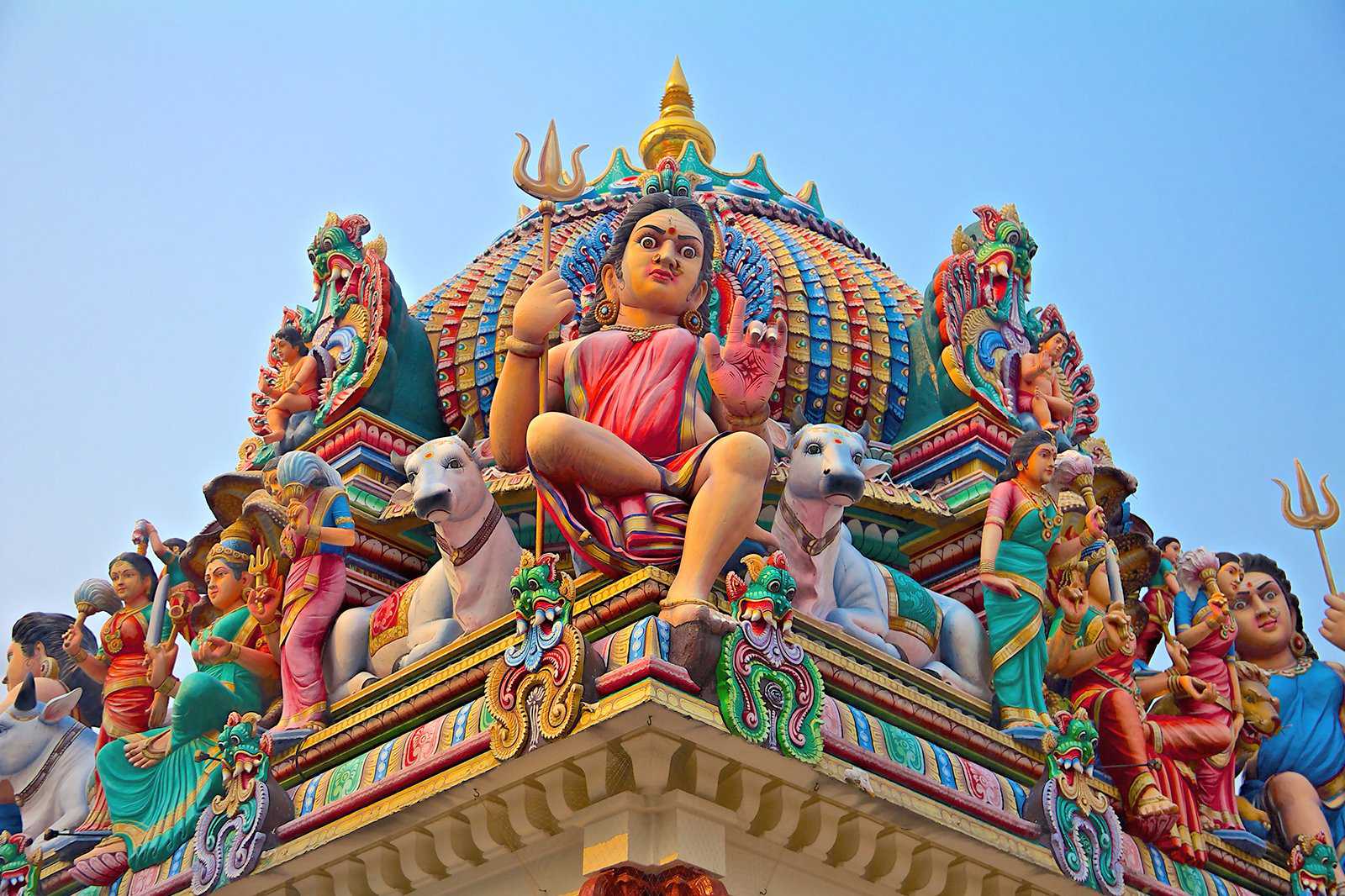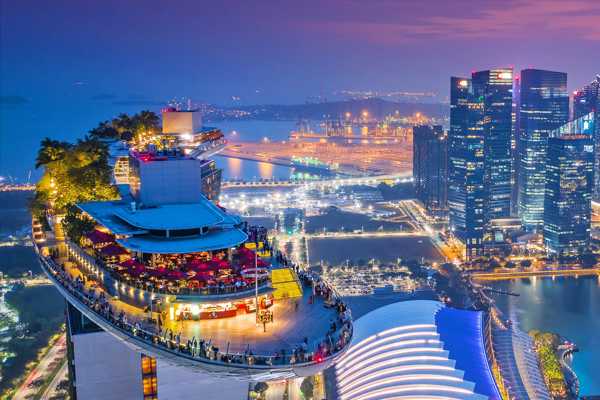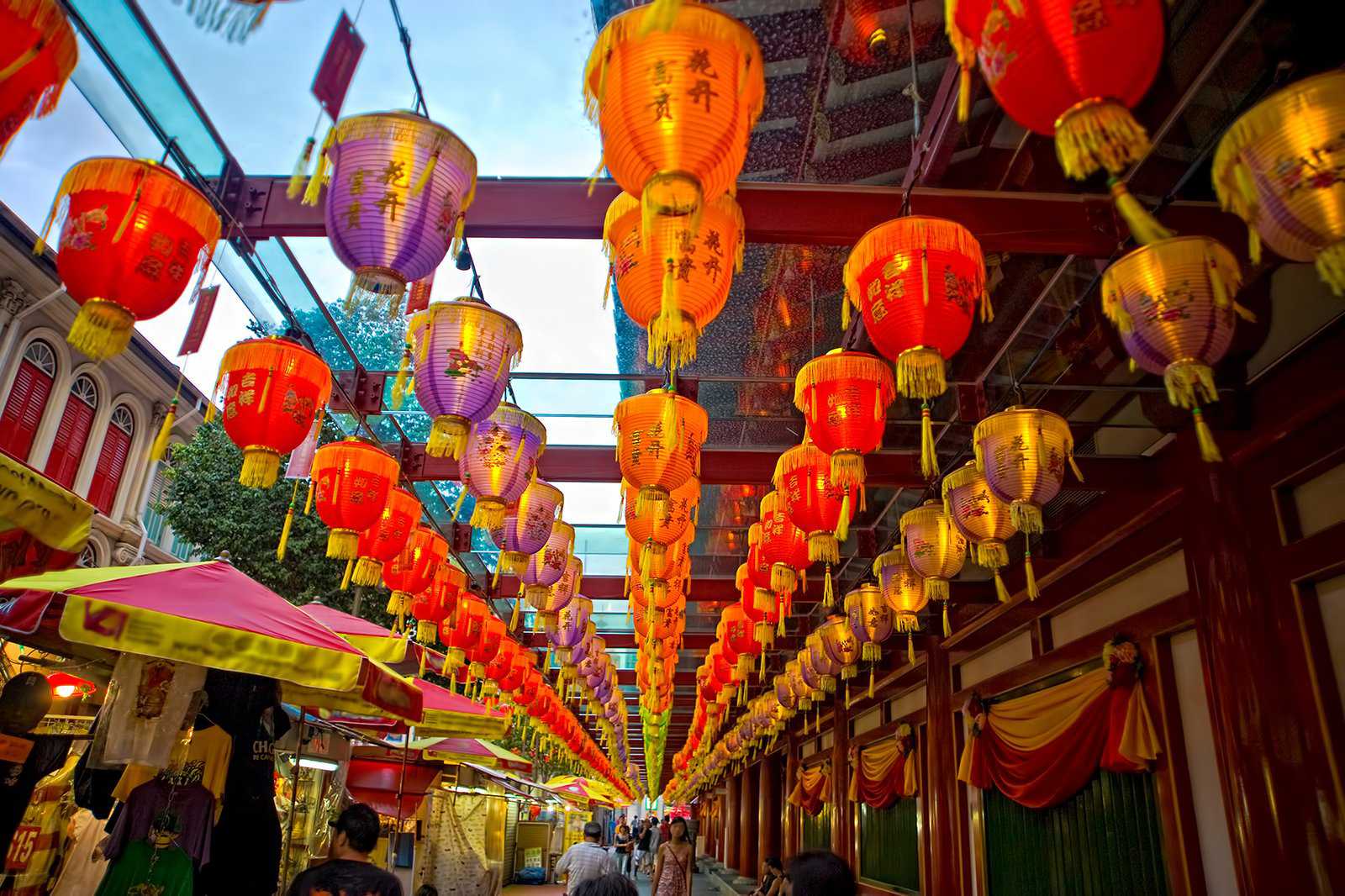Festivals in Singapore are a true reflection of the incredible diversity of this tiny city-state. The people of Singapore are comprised of multiple ethnicities, cultures and religious backgrounds, and the festivals across the island cater for all. The vast Chinese community celebrate their New Year in February, Vesak Day in May is a vibrant and colourful festival for Singaporean Buddhists, and Deepavali in October is the most significant date on the Hindu calendar.
Alongside the more traditional festivals, Singapore also boasts a whole host of more contemporary events that unite the whole country, including food festivals, National Singapore Day (on August 9th), marathons and the Formula 1 Grand Prix, which transforms the city-centre into a racing track across 3 days in September. Discover the best annual festivals in Singapore, all in chronological order, below.
- 1
Thaipusam

- Lavt budget
- Historie
- Billeder
This famous Hindu festival has to be witnessed to be believed. In a gesture of penance and seeking forgiveness from the gods, male Hindu devotees make the 3-kilometre walk from Sri Srinivasa Perumal Temple to Sri Thandayuthapani Temple, laden with enormous kavadi, or portable shrines.
The kavadi is pierced to the devotees' body by spikes and skewers; it is normally borne on the body, and sometimes dragged by the devotee like a chariot. Supporters of the kavadi-bearer gather around him, chanting prayers, clapping and shouting their encouragement along the way. This fascinating, logic-defying ceremony lasts the entire day, and observers are welcome.
- 2
River Hong Bao

- Lavt budget
The River Hong Bao Festival is an annual fair that takes place at the breezy waterfront area near Marina Promenade. The fair is usually built along the theme of the relevant Chinese zodiac symbol for that coming year. Expect huge floats depicting the animals of the Chinese zodiac, as well as huge statues of the Gods of Fortune and Wisdom, colourful temples and bridges, and "cherry blossom" trees everywhere. The stalls will feature the best in arts and crafts, Chinese calligraphy, and even palm reading, from Taiwan and China. Cultural performances will be held nightly.
Billede taget af Marcin Konsek (CC BY-SA 4.0) Redigeret
- Lavt budget
Læs mereThis is, without a doubt, the most important festival of the Chinese lunar calendar. Also known as the Lunar New Year, this festive period lasts for 15 days and usually falls during the months of January and February. The whole island seems to stop to celebrate this special period, but the liveliest events, of course, are to be found at Chinatown.
The night before the first day of Chinese New Year, Chinese people all over Singapore make it a point to rush home for the annual family reunion dinner, which marks the start of a period of feasting. Chinese New Year cookies such as love letters and pineapple tarts (a Singapore-Malaysia invention), barbecued pork and sumptuous Chinese dinners are usually featured.Another New Year specialty which originated in Singapore and Malaysia is yu sheng, or raw fish in a colourful bed of salad. The fish symbolises a prosperous life, and each colour in the salad brings a special significance as well. Yu sheng is not meant to be nibbled at demurely, you have to eat it with a whole bunch of people who will all dig in their chopsticks and toss the salad as high as possible. This noisy ritual is called lo hei, and is meant to bring you good health and luck for the rest of the year.
If you visit the home of your Chinese friends during this period, bring along a pair of mandarins as a token of good fortune. You will probably get hong baos in return; these are red packets containing money, and are, not surprisingly, kids' favourite part of Chinese New Year. Wish your hosts Gong Xi Fa Cai, it's the traditional greeting during the celebration and means you wish them lots of prosperity and good fortune.
In the weeks running up to Chinese New Year, Chinatown's the place to be. Colourful stalls line the streets, selling everything from red and gold greeting cards to love-letters cookies to pussy willow (a symbol of longevity). You'll smell incense and see little altars everywhere, as the Chinese make offerings to their gods.
Two other major events are held in Singapore in connection to Chinese New Year - the River Hong Bao Festival and the Chingay Parade.
- 4
Chingay Parade

- Lavt budget
The Chingay Parade is the biggest parade in Singapore. Originating as a procession to mark the Chinese New Year festivities, the parade has evolved into an international event, featuring everything from Taiwanese acrobats to salsa dancers.
The atmosphere is definitely carnival-like, as the procession of dancers, gymnasts, beauty queens and children make their way from City Hall to Suntec City. You can catch them at any point along the way, although there are designated spots where the dancers and acrobats will stop to stage their performances. Look out for traditional Chinese performances, such as lion dances, alongside cultural shows from countries as far-flung as Denmark and Papua New Guinea.
Billede taget af Greg Hume (CC BY-SA 3.0) Redigeret
- 5
Qing Ming Festival

- Lavt budget
During the Qing Ming Festival, temples are fully packed with Chinese believers who flock there at the crack of dawn. Throughout the day, families wrestle shoulder-to-shoulder amidst thick smoke of burning joss sticks; their hands full with Chinese pastries and all kinds of food and incense for their ancestors. For some, Qing Ming is a trip to the cemetery where family members clean up the graves of their ancestors and offer prayers in remembrance of the deceased. The best place to observe the ceremonies is Kong Meng San Phor Kark See Temple at Sin Ming Road.
Billede taget af Jacklee (CC BY-SA 3.0) Redigeret
- 6
Good Friday

- Lavt budget
Good Friday is an important religious day for many Christians and it commemorates the crucifixion of Jesus Christ. In churches all over Singapore, special prayer services are held. At the St. Joseph's Catholic Church on Victoria Street, Catholics clasp white candles in a moving procession bearing the figure of the crucified Christ.
Billede taget af Iloilo Wanderer (CC BY-SA 4.0) Redigeret
- 7
Vesak Day

- Lavt budget
Vesak Day For Buddhists the world over marks the birthday of the Lord Gautama Buddha. In Singapore, the many followers of Buddha pay a visit to the various Buddhist temples dotting the island for a day of worship and prayer.
Priests in the newest saffron-coloured robes chant blessings and sprinkle holy water at the devotees, and for many Buddhists this is the time to re-dedicate themselves to the central teachings of Gautama - moderation and the release from worldly desires. In many temples, priests will release a flock of doves from a cage, to signify humanity's freedom from earthly bondages.
Priests in the newest saffron-coloured robes chant blessings and sprinkle holy water at the devotees, and for many Buddhists this is the time to rededicate themselves to the central teachings of Gautama - moderation and the release from worldly desires. In many temples, priests will release a flock of doves from a cage, to signify humanity's freedom from earthly bondages.
Billede taget af Dorje tenzin (CC BY-SA 4.0) Redigeret
- 8
Dragon Boat or Rice Dumpling Festival

- Lavt budget
- Familier
- Billeder
The fifth day of the fifth month of the lunar calendar is not only a day to enjoy rice dumplings wrapped in leaves or to watch the dragon boat races. Legend has it that on this day, Qu Yuan, a patriot of ancient China, threw himself into the Mi Luo River in protest against corruption and injustice. The story goes that when the fishermen heard of Qu Yuan's suicide, they immediately set forth in their boats to look for him. Thus began the tradition of having dragon boat races . Desperate to prevent fish from devouring his body, fishermen also threw rice into the river - thus beginning this delightful tradition of dumpling eating.
- 9
Singapore Triathlon

- Oplevelser
Singapore Triathlon is an annual event organised by Triathlon Association of Singapore (TAS). The triathlon would require the athlete to swim 1.5km in the open sea, cycle 40km and run a gruelling 10km. In addition to the above, there are different distance for various other race categories (Students, corporate, mini-triathlon) The event is part of the Asia-Cup Series, where elite athletes are able to gain points for the ranking amongst triathletes in Asia.
- 10
Festival of the Hungry Ghost

For the Chinese, the month of the Hungry Ghosts or Spirits - usually in the month of August - is the most inauspicious time of the year. Taoists believe that the gates of Hell are opened at this time, and the spirits of the departed wander freely about the earth.
Children are discouraged from staying outdoors late at night, it is considered unlucky to buy a piece of property or close a business deal, and some market pundits have observed that even the stock market is quieter during the Hungry Ghosts month. The ghosts are "hungry"after their impoverished time in Hell.
Besides burning huge joss-sticks and candles, Taoist believers offer cakes, fruits and sometimes an entire banquet to appease the famished spirits. Fake paper money - and sometimes even fake paper cars, houses and mobile phones - are burnt so that the dead spirits will have the actual equivalent of these objects in the afterlife. Street shows are also held to appease the hungry souls.
This is a heady time where the air is heavy with tradition and superstition, and is worthwhile paying a visit to Chinatown for.
- 11
Hari Raya Haji

Muslims celebrate Hari Raya Haji, to mark the pilgrimage of devotees to the holy city of Mecca. This religious festival is celebrated with the sacrifice of animals at dawn, and prayers at the mosque.
Muslim families visit each others' homes, and those who have made the all-important pilgrimage are the focus of much attention.
- 12
Mooncake Festival

- Lavt budget
- Familier
The Mooncake Festival is also known as the Lantern Festival or the Mid-Autumn Festival, and occurs usually in the month of September. It is held on the 15th day of the eighth month of the Chinese lunar calendar, when the moon is at its fullest and brightest. In ancient China, it was the celebration of a bountiful harvest in the middle of autumn.
Many romantic legends surround this festival. One tale tells of how the Chinese succeeded in overthrowing the Yuan dynasty through a series of secret messages tucked into round, sweet pastries made of flour, oil and lotus seed - mooncakes. Another legend has it that the moon became the final abode of the legendary Chang Er and her pet rabbit - and on a clear night, one might just see them!
Today, these legends live on in the eating of mooncakes - they come in many different varieties now, even "mocha cream" - and the lighting of lanterns. On the night of the festival, children light up brightly-coloured lanterns in the shape of fishes, squirrels or butterflies (the more enterprising have Hello Kitty) and many corners in the suburbs become a regular fairyland of lights.
In the streets of Chinatown, the stalls are stocked with mooncakes and other tidbits, and events such as bonsai competitions and tea-making demonstrations. This is also the ideal time to go for an evening stroll in the Chinese Gardens in Jurong - hundreds of Chinese lanterns adorn the park, making for a very pretty sight indeed.
- 13
Singapore Grand Prix

Singapore Grand Prix is the only Formula One race held at night, presenting a mixture of top music performances and enhanced on-track action. This year’s Singapore Grand Prix is set to be bigger and better than last year’s, with top international names in motorsports and music set to rock the Marina Bay Street Circuit. Maximising on the entertainment value for fans of F1, the Singapore Grand Prix is an unforgettable occasion that is so much more than just another racing event.
- 14
Nine Emperor Gods Festival

- Lavt budget
- Billeder
This Chinese festival lasts for nine days. Following the Chinese lunar calendar,it is usually held during September and/or October. Activites centre around the Nine Emperor Gods Temple at Upper Serangoon Road (near Little India!). You will find the temple near Yio Chu Kang Road.
This is a noisy celebration, as Chinese worshippers welcome the visitation of the Nine Emperor Gods who bring good fortune, longevity and health to the sound of drums and cymbals. Priests write out protective charms with their blood, and the festival climaxes with a parade of the nine gods, each carried in a large and elaborate sedan chair.
Billede taget af Basile Morin (CC BY-SA 4.0) Redigeret
- 15
Navratri

- Lavt budget
- Billeder
This Hindu festival lasts the entire month of October, although nine nights are singled out as days of especial celebration. Navarathiri means "nine lights" in Tamil, and this festival is dedicated to the Hindu goddesses Dhurga, Lakshmi and Saraswathi. The event is celebrated in the various Indian temples across Singapore, where special prayers and performances of traditional Indian music and dance are held in the evenings.
The centrepiece of the festivities is at the Sri Thandayuthapani Temple at Tank Road, which for nine nights echoes with the sound of worship, dance and celebration. A vibrant procession of Hindu devotees - led by a beautiful glittering horse - is held on the tenth night.
- 16
Theemidhi

- Lavt budget
- Billeder
This famous Hindu fire-walking ceremony brings out the devotees and the tourists alike. On October at the Sri Mariamman Temple in the centre of Chinatown, Hindu devotees walk across a 4-metre pit of red-hot coals in honour of the bravery of the goddess Draupadi. They complete the fire-walking ceremony, a test of endurance and faith, walk miraculously unhurt.
The day-long Thimithi festival celebrations begin at 2pm, with the fire-walking ceremony starting at 5pm.
- 17
Deepavali

- Lavt budget
- Billeder
Deepavali, the most important date of the Hindu calendar, occurs on one day during October, and in the ethnic quarter of Little India, the festivities last practically for the whole month of October.
Deepavali is the Festival of Lights, and marks the defeat of the evil Narakasura by the Lord Khrishna. All round the world, Hindus celebrate this day as the triumph of light over darkness, and of good over evil. It marks the New Year for Hindu devotees, and is a great time of rejoicing and renewal.
During this time, Little India throbs with evening roadside stalls, booming music and strings of colourful lights. Shoppers throng the streets in search of the perfect sari to wear, or to fill their baskets with Indian foods and spices. Hindu homes are lighted with oil lamps, and offerings of sweetmeats and garlands of jasmine are placed at the family altar.
The streets and temples of Little India are lit up with streamers and fairy lights lining the streets and forming arches and gateways to the night bazaars.The Sri Veeramakaliamman, Sri Vadapathira Kaliammanand and Sri Srinivasa Perumal temples are garlanded in lights as the whole of Serangoon Road glitters to welcome the New Year.
Campbell Lane, meanwhile, takes on the mood of a street carnival for 21 days. The Deepavali Festival Village features stalls offering Indian costumes, jewelry, foods, furniture and arts and craft. Every evening except on Sundays, right up to the even of Deepavali, local and foreign artistes perform South and North Indian songs and dances.
- 18
Singapore Marathon

- Oplevelser
Calling all marathon enthusiasts. The Marathon, an annual event in the local sports calendar features both the local and international athletes. The Marathon provides local participants with an opportunity to run with seasoned marathoners and learn the finer points of marathon running. The Singapore Sports Council also believes that the marathon is a test of not only endurance, but also one’s mental fitness. For those who love running long distances, completing a marathon is an ultimate goal.
- 19
Christmas

- Par
- Familier
- Billeder
- Shopping
Christmas, on December 25, is a time of full-blown celebration in Singapore. All the trappings of a traditional Christmas are here - Christmas carolling, late-night mass, nativity scenes, winking fir trees and gaily-wrapped presents.
You won't find snow, of course, in tropical Singapore, but no matter - the shopping malls are sprayed with "frost", and some even have special snow-making machines for the delight of children. High-tea and dinner at many hotels at this time will feature stuffed turkey, Christmas pudding and log cakes.
Christmas is when the shopping artery of Orchard Road basks in all its glory. From mid-November to early January, the street is festooned with streamers, holly and bells, and at night it is lit up by thousands of fairy lights The shopping malls play host to special Christmas performances and carolling groups. They also vie with each other to see who will carry away the annual Best Decorated Building title, so look out for some spectacular shop fronts and displays built around various themes.
- 20
New Year's Eve

Don't miss the biggest party night in town! Celebrate the New Year at the enormous Fountain of Wealth at Suntec City, where live music and street dancing will keep you dancing until the wee hours of the morning. Or, if you prefer the beach atmosphere, head for Sentosa Island, where the mood is easy and the margarita flows easy.
If you prefer to greet the New Year with your nearest and dearest - rather than in the midst of a huge crowd - there are countless bars, restaurants and hotels which will hold special events.


















